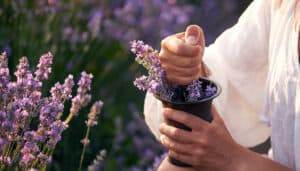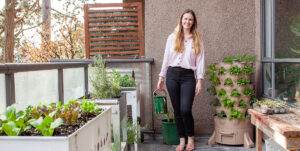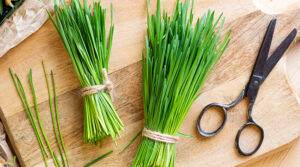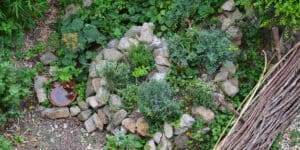Why Use Natural Fertilizers?
Natural fertilizers not only feed your plants, they replenish and rejuvenate the soil, stimulating activity from beneficial microbes, insects and animals. They add raw energy to the soil which creates a living, symbiotic ecosystem. Roots readily absorb these nutrients and thrive with lush vegetative growth and abundant flowers and fruits.
Most natural fertilizers are byproducts of the agricultural industry making them renewable, sustainable and a no-brainer choice for organic minded gardeners. There truly is no waste in regenerative gardening, all parts of plants and animals can be repurposed and used with intention. By using natural amendments you take advantage of nature’s clever design. It makes perfect sense to incorporate organic compounds when we understand the needs of plants and their environment.
Gardeners are not doing themselves any favors, or setting a good example, if they depend on chemical fertilizers or poison pesticides, especially around their homes or on the food they grow to feed their families. We can all do our small part to benefit the earth and environment, why not start in our own gardens?
Conventional fertilizers are manufactured synthetically, damaging the environment in many ways. These highly concentrated forms of nitrogen, phosphorus and potassium don’t effectively break down in the soil and result in toxic runoff. This harms every form of life in our waterways, earth and air. Sure you might get unnaturally huge plants by feeding with miracle grow, but is it worth it? How is the flavor and nutrition of that produce? Consider the depletion and imbalance of nutrients caused to the soil. How much of that chemical fertilizer has leached into the food you’re putting into your body? These are the concerns that creep into my mind.
On the other hand, organic fertilizers are cheap, practical and can be sourced easily. They will efficiently feed the plants and soil, bringing your garden and landscape into harmony with nature. Plants, like humans, and all living things, require a wide variety of nutrients. Incorporate these organic fertilizers into your garden to improve your garden’s vitality and bounty.
Compost
Compost is a mixture of thoroughly decomposed organic materials. For many reasons it should be integrated as much as possible into the home garden.
First of all, it instantly improves soil quality. If drainage or moisture retention problems plague your garden, mix in some compost to quickly alleviate these issues.
Compost will also add plenty of localized living microorganisms to your soil. This increases the cation exchange rate, allowing plants’ roots to absorb nutrients more efficiently.
Containing mild levels of nutrients itself, compost will never burn your plants, but can directly feed them incrementally throughout the season.
Compost can be added before, during, in between or after plantings. Use it as a mulch to suppress weeds and help retain moisture during the growing season.
It can be used to brew compost tea, which is a more potent, direct form of feeding plants. A shot of essential nutrients and microbes, use it as a mid season pick me up or regular feed for waning garden plants.
Compost is cheap and readily available at garden centers and local farms. It’s also free (!) if you build your own pile or bin. Making your own compost is an excellent way to repurpose all of your organic waste instead of sending it to the landfill.
Fish Emulsion
Fish emulsion is one of my go to fertilizers. I’m a big fan because it can be easily and broadly applied throughout the season with fast, evident and excellent results, not so much the smell, look or texture (it’s gross). Fish emulsion is basically scrap fish parts that have been dried, fermented and all blended together into a smoothie-like consistency. This makes it easy to dilute into water to be used at watering time or even as a foliar spray fertilizer. The water soluble fertilizer is readily absorbed by roots and foliage, making it fast acting. Positive effects are noticeable in a short time. It tends to have an even balance and moderate levels of nitrogen, phosphorus and potassium. Fish emulsion will also provide your plants with enzymes and amino acids, nutrients lacking in many fertilizers. Just follow the instructions on the label and don’t go overboard, it is quite acidic. In general, it’s a great all purpose fertilizer that can be applied regularly throughout the growing season. And don’t worry, you’ll get used to the smell.
Seaweed/Kelp
Seaweed fertilizers are very popular because of their high levels of trace minerals. Fertilizers don’t need to be loaded with nitrogen, phosphorus or potassium to be valuable to the health of your garden. In fact, overfeeding is a common problem when obsessing over NPK. Seaweed fertilizers don’t mess with this equilibrium at all, as they gently contribute a wide spectrum of bioavailable micronutrients like magnesium, zinc and iron. Certain hormones contained within seaweed work to stimulate root growth. The salt content can also drive away slugs and other pests. Seaweed and kelp fertilizers can be found in liquid or dry powdered meal form. Some people that live close to a body of water even collect their own fresh and add it directly to their garden. I prefer to use a liquid kelp fertilizer, it dissolves easily and can be incorporated into your watering schedule. It makes a great foliar spray as well. This is another staple for my feeding routine that I usually alternate with fish emulsion.
Crab/Lobster Shell
Keeping with the seafood theme, crustacean shell meal is an excellent additive for gardens. The crushed shells of these sea creatures will feed beneficial microorganisms in the soil while slowly releasing nitrogen, calcium, phosphorus and magnesium. Chitin, a material found abundantly in shells and exoskeletons, will attract earthworms and deter harmful nematodes. The shell meal can be distributed throughout the garden a few weeks before planting, or added directly into planting holes. The tiny sharp shards will keep slugs and grubs far away from your garden. It will also help prevent root rot, blight and powdery mildew. There’s no real risk of burning your plants by adding shellfish meal. At the beginning of every season I work a good amount into all of my garden beds.
Blood Meal
Blood meal is exactly what it sounds like, dried, powdered blood from slaughtered livestock. If it isn’t too gruesome of a concept for you, the all natural product can add a huge boost of nitrogen to the garden. Mix into garden beds before planting, or use it sparingly during the growing season for plants that are struggling to grow vegetatively. It will green up leaves, strengthen stalks and stems, providing a better frame for the plant to produce healthy flowers and fruit. Because it’s so rich in nitrogen and very acidic, blood meal can just as easily burn plants. Be sure to always follow instructions on the package and maybe even start with half the prescribed amount. Beware that it can attract hungry, curious critters.
Bone Meal
Another animal byproduct, bone meal is the ground bones of cattle. It will provide your garden with a huge amount of phosphorus, especially important for fruiting and flowering plants. Work it into your garden early in the spring or sprinkle some into the planting holes at the time of transplanting. Bone meal will help balance soils that are very acidic and high in nitrogen, while supplying a good dose of calcium, a critical nutrient often used up quickly and depleted. In my own experience, I’ve noticed that applying bone meal increases yields of heavy feeding, fruiting plants like tomatoes, peppers and eggplant. But always start with small applications, as it does contain an excessive amount of phosphorus, which at high levels can lockout other nutrients. Store it well, out of the reach of children, pets and wildlife.
Feather Meal
Feather meal is most effectively used as a way to add a large amount of nitrogen to your gardens prior to planting. Produced by grinding down poultry feathers, feather meal will greatly benefit the early vegetative growth of your plants while building a healthy soil structure. Mixed into the top layer of soil it will break down quickly, feeding microbes and plant roots. Unfortunately, the conditions of many poultry farms are substandard, to put it kindly. Because of this, do your due diligence when searching for quality feather meal. It can be an excellent fertilizer, just be sure you trust the source and their production practices.
Alfalfa Meal
Alfalfa is commonly grown as a cover crop and/or feed for livestock. It’s very effective in both capacities because it fixes nitrogen into the soil and its solid protein content satiates hungry farm animals. Alfalfa meal can be found at garden centers as a fertilizer/soil conditioner. It contains moderate amounts of nitrogen and potassium and works exceptionally well as an early season amendment for garden beds. Alfalfa meal adds organic material that will slowly release over the course of a season, gradually breaking down to feed the soil and your plants. A very effective supplement to incorporate into large planting fields as well to improve soil quality.
Molasses
Molasses may seem out of place in the garden, but it actually makes a healthy natural fertilizer. Look for unsulfured blackstrap molasses to get the most nutrition. Molasses adds nutrients like manganese, magnesium, potassium, iron and calcium. The high sugar content will provide plenty of energy for the microbes in the soil. It can also be added to compost tea brews as a catalyst to stimulate microbial activity. Molasses dissolves easily into water and can be fed to plant roots or applied as a foliar spray. It is quite acidic however, and shouldn’t be used too liberally. About one tablespoon per gallon of water is a good ratio to start with. In my experience, a regular small dose of molasses can lead to bigger buds, flowers and fruit that have a richer depth of flavor.
Epsom Salt
Epsom salt is commonly found in pharmacies and grocery stores because of its variety of uses. It is made up of magnesium and sulfur, chemically known as magnesium sulfate, which are both needed for proper plant growth and development. Sulfur is rarely lacking in the soil, but magnesium deficiency and limited uptake can be a big problem for some garden fruits and vegetables, especially the heavy feeders. Magnesium is critical for the production of chlorophyll and fruits. It also strengthens cell walls and improves the uptake of other important nutrients. Epsom salt is very water soluble. For all of these reasons I like to use it as a foliar fertilizer spray, especially at the time of fruiting with crops like tomatoes, peppers and eggplant. Scientific research has been slow to study the relationship of epsom salt and plant health. But from what I can tell, for what it’s worth, fruits seem to bulk up and grow to larger sizes with a regular application. As a bonus it’s a good natural pesticide when sprayed on leaves or sprinkled into the soil around the base of plants.
Cover Crops/Green Manure
Cover crops aren’t technically a fertilizer, as they’re not a finished product you simply add to the soil. They do however merit a mention because of their importance in sustainable growing. Cover crops should be seriously considered by gardeners that consistently grow heavy feeding crops.
Corn, tomatoes, peppers, eggplant, broccoli, cucumbers, melons, pumpkins and squash all demand large supplies of nutrients. These popular crops grown in the same space year after year will inevitably lead to soil depletion and invite disease. To break up this unfortunate side effect, consider a crop rotation plan, which will alternate different plant types through a beneficial progression over the course of a few seasons.
Cover crops can play a big part in this rotation. Consider giving certain beds or portions of your garden a rest every few years by growing a cover crop that will replenish nutrients and reestablish microbial activity. Alfalfa and different varieties of peas and clover are commonly used as cover crops.
Green manures are crops specifically grown to be chopped down then left in place to decompose and feed the soil. They can be grown before or after regular crops, or cultivated all season long as a cover crop. Oats, peas, buckwheat, vetch, ryegrass and mustard can all be used as green manures.
Try utilizing some cover crops and green manures to condition your soil, replenish nutrients, suppress weeds and help prevent erosion in the offseason.
Fertilizer For Thought
Organic fertilizers are the obvious choice for conscientious gardeners. Synthetically produced, chemical fertilizers are the antithesis of regenerative growing. Let no valuable byproduct go to waste and use natural substances to fuel and feed your crops. The extra attention and effort will be evident in the quality, taste and nutrition profile of the produce. In this way we can connect all links of the chain that is the cycle of life and secure a more sustainable future.







